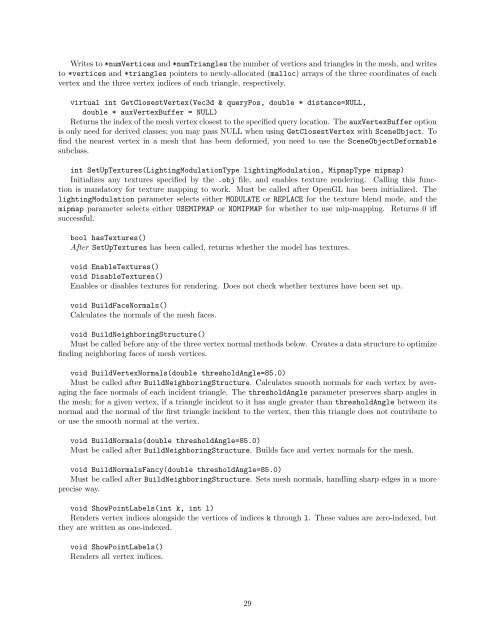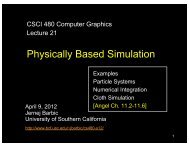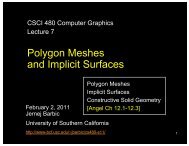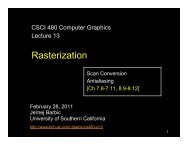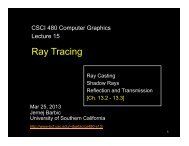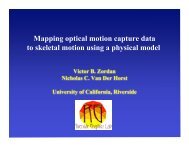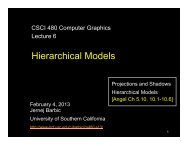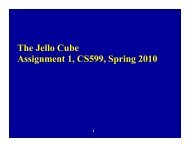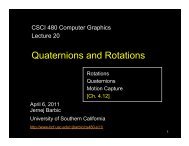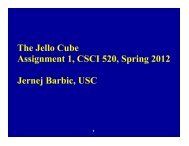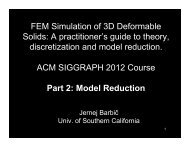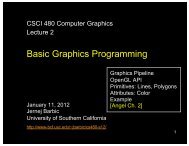Vega FEM Library (v1.1) User's Manual - University of Southern ...
Vega FEM Library (v1.1) User's Manual - University of Southern ...
Vega FEM Library (v1.1) User's Manual - University of Southern ...
You also want an ePaper? Increase the reach of your titles
YUMPU automatically turns print PDFs into web optimized ePapers that Google loves.
Writes to *numVertices and *numTriangles the number <strong>of</strong> vertices and triangles in the mesh, and writes<br />
to *vertices and *triangles pointers to newly-allocated (malloc) arrays <strong>of</strong> the three coordinates <strong>of</strong> each<br />
vertex and the three vertex indices <strong>of</strong> each triangle, respectively.<br />
virtual int GetClosestVertex(Vec3d & queryPos, double * distance=NULL,<br />
double * auxVertexBuffer = NULL)<br />
Returns the index <strong>of</strong> the mesh vertex closest to the specified query location. The auxVertexBuffer option<br />
is only need for derived classes; you may pass NULL when using GetClosestVertex with SceneObject. To<br />
find the nearest vertex in a mesh that has been deformed, you need to use the SceneObjectDeformable<br />
subclass.<br />
int SetUpTextures(LightingModulationType lightingModulation, MipmapType mipmap)<br />
Initializes any textures specified by the .obj file, and enables texture rendering. Calling this function<br />
is mandatory for texture mapping to work. Must be called after OpenGL has been initialized. The<br />
lightingModulation parameter selects either MODULATE or REPLACE for the texture blend mode, and the<br />
mipmap parameter selects either USEMIPMAP or NOMIPMAP for whether to use mip-mapping. Returns 0 iff<br />
successful.<br />
bool hasTextures()<br />
After SetUpTextures has been called, returns whether the model has textures.<br />
void EnableTextures()<br />
void DisableTextures()<br />
Enables or disables textures for rendering. Does not check whether textures have been set up.<br />
void BuildFaceNormals()<br />
Calculates the normals <strong>of</strong> the mesh faces.<br />
void BuildNeighboringStructure()<br />
Must be called before any <strong>of</strong> the three vertex normal methods below. Creates a data structure to optimize<br />
finding neighboring faces <strong>of</strong> mesh vertices.<br />
void BuildVertexNormals(double thresholdAngle=85.0)<br />
Must be called after BuildNeighboringStructure. Calculates smooth normals for each vertex by averaging<br />
the face normals <strong>of</strong> each incident triangle. The thresholdAngle parameter preserves sharp angles in<br />
the mesh; for a given vertex, if a triangle incident to it has angle greater than thresholdAngle between its<br />
normal and the normal <strong>of</strong> the first triangle incident to the vertex, then this triangle does not contribute to<br />
or use the smooth normal at the vertex.<br />
void BuildNormals(double thresholdAngle=85.0)<br />
Must be called after BuildNeighboringStructure. Builds face and vertex normals for the mesh.<br />
void BuildNormalsFancy(double thresholdAngle=85.0)<br />
Must be called after BuildNeighboringStructure. Sets mesh normals, handling sharp edges in a more<br />
precise way.<br />
void ShowPointLabels(int k, int l)<br />
Renders vertex indices alongside the vertices <strong>of</strong> indices k through l. These values are zero-indexed, but<br />
they are written as one-indexed.<br />
void ShowPointLabels()<br />
Renders all vertex indices.<br />
29


